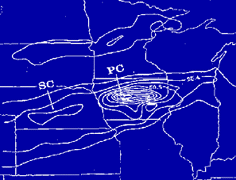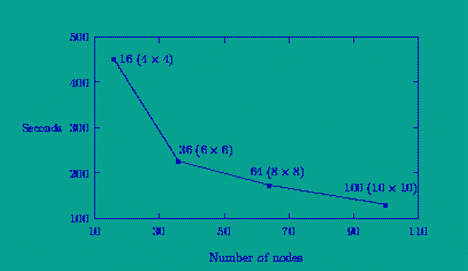 Fig. 2
Fig. 2  Fig. 3
Fig. 3
Objective: To develop and implement a massively parallel version of a mesoscale meteorological model with both hydrostatic and non-hydrostatic options and evaluate the model performance in simulations of real events of societal importance.
Approach:
Accomplishments: The hydrostatic version of a community mesoscale model (MM5) has been parallelized and is being tested. The nonhydrostatic version (previously parallelized by Argonne National Laboratory) has been used to simulate events from the Great Flood. Fig. 1 shows the speed-up achieved by use of multiple processors. Fig. 2 shows the simulated 24-hour rainfall pattern for 7/8/93, which compares favorably with the observed precipitation pattern shown in Fig. 3. Model resolution is 30 km in the horizontal directions.
 Fig. 1
Fig. 1
Significance: Simulations at various resolutions have demonstrated that 30-km resolution is required for accurate simulation of summertime precipitation events. Speed-up plateaus beyond 64 processors for the non-hydrostatic code need to be sought as additional opportunities for increasing performance.
 Fig. 2
Fig. 2  Fig. 3
Fig. 3
Status/Plans: Through timing tests on the soon-to-be-completed hydrostatic code and development of a diagnostic tool, we will continue to search for opportunities for speed-up through parallelization.
Point of Contact:
Dr. Eugene S. Takle
Iowa State University
gstakle@iastate.edu
515-294-9871
URL: http://www.public.iastate.edu/~wxintro/faculty/takle.html